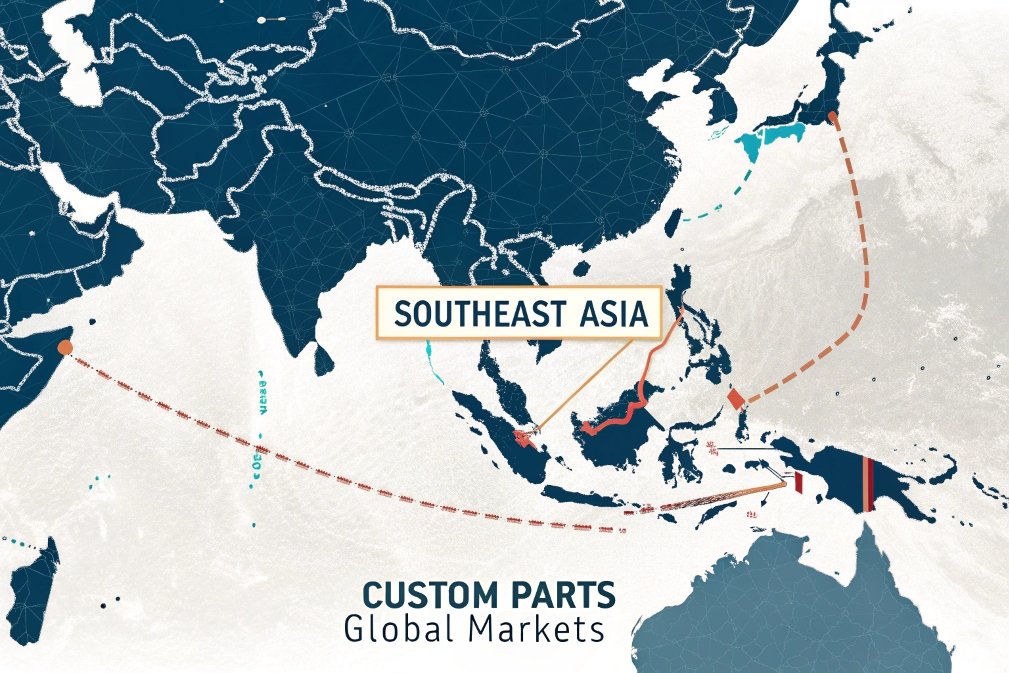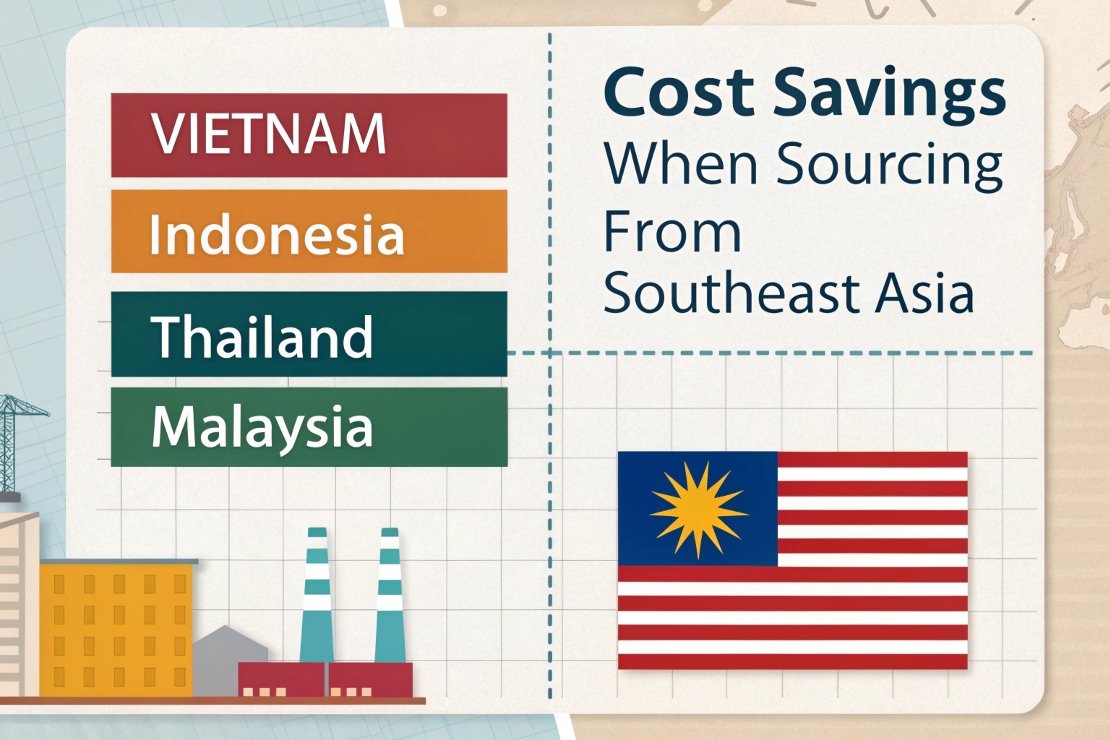
As a business owner, I know that sourcing from Southeast Asia has become increasingly popular for companies looking to cut costs, improve product quality, and stay competitive in today’s global market. But what makes Southeast Asia such a hot spot for sourcing, especially when it comes to custom parts? Let me break it down for you.
Southeast Asia offers several benefits for businesses seeking to source custom parts, including cost efficiency1, strategic location, and a skilled workforce2. The region’s manufacturing capabilities are highly regarded, especially in countries like Vietnam, Thailand, and Indonesia.
Sourcing custom parts from Southeast Asia allows businesses to tap into cost-effective manufacturing options, leverage strategic trade routes, and benefit from expertise in various industries. But what’s the real story behind the region’s appeal? Let’s dive deeper into the specifics.
Why Is Southeast Asia a Strategic Location for Sourcing Custom Parts?

Southeast Asia’s strategic location3 provides easy access to major global markets, including the US, Europe, and other parts of Asia. This makes it a prime choice for businesses seeking to streamline their supply chain and reduce costs.
From its proximity to major shipping routes to its extensive network of ports and transportation infrastructure, Southeast Asia offers unmatched logistical advantages for sourcing parts. Whether you’re importing custom mechanical parts or components for larger machinery, the region ensures smoother access to international markets.
Logistics and Shipping Efficiency
The region’s central position between the East and the West means that goods can be shipped faster and more cost-effectively. Major ports like Singapore, Ho Chi Minh City, and Jakarta are hubs for international trade, providing businesses with efficient shipping options. Furthermore, with trade agreements in place, such as the ASEAN Free Trade Area (AFTA), businesses can also benefit from reduced tariffs when sourcing from Southeast Asian countries.
| Country | Key Port | Major Export Markets | Average Shipping Time to US (Days) |
|---|---|---|---|
| Vietnam | Ho Chi Minh City | USA, EU, China | 20-25 |
| Indonesia | Jakarta | USA, Japan, Australia | 25-30 |
| Thailand | Bangkok | USA, China, EU | 18-22 |
| Malaysia | Port Klang | USA, Japan, Singapore | 18-20 |
With shorter shipping times and access to major global markets, sourcing from Southeast Asia can significantly enhance your supply chain efficiency. The region’s logistics infrastructure ensures that companies like yours can get their custom parts delivered quickly and at lower shipping costs.
Cost-Effective Labor and Manufacturing
Another major advantage of Southeast Asia is its relatively low labor costs compared to other regions like North America or Europe. This cost advantage makes it possible for companies to produce high-quality custom parts at a fraction of the price, even after factoring in shipping and tariffs. As a result, businesses can reduce their overall production costs and increase their profit margins.
How Does Sourcing from Southeast Asia Affect Costs and Lead Times?

Sourcing from Southeast Asia is often associated with lower costs and shorter lead times, which can have a direct impact on your bottom line. By working with suppliers in the region, companies can access cost-effective production while keeping delivery times in check.
Many businesses choose Southeast Asia because it offers a combination of affordable manufacturing and reliable, timely production. Lead times are often shorter than those in China, and shipping costs can be more favorable due to the proximity of key ports and transportation networks.
Cost Reduction Strategies
In countries like Vietnam, Indonesia, and the Philippines, the overall cost of production—including labor, raw materials, and overheads—tends to be lower than in more developed regions. This allows companies to save significantly on their custom parts, while still receiving high-quality products. Lower labor costs help manufacturers stay competitive, and you can still get the quality you need for your custom parts, all while keeping your production costs down.
| Country | Average Labor Cost per Hour (USD) | Manufacturing Cost per Unit (USD) |
|---|---|---|
| Vietnam | 2.50 | 1.80 |
| Indonesia | 2.00 | 2.10 |
| Thailand | 3.50 | 2.40 |
| Malaysia | 4.00 | 2.50 |
Impact on Lead Times
The lead time for sourcing custom parts from Southeast Asia can be shorter compared to traditional sourcing locations like China. The efficient logistics infrastructure and the region’s proximity to global markets mean that businesses often experience faster turnaround times. This is crucial for businesses that operate on tight deadlines or those that need to respond quickly to changes in market demand.
Southeast Asian suppliers typically have the flexibility to meet varying order sizes and offer quick turnarounds, making it an attractive choice for businesses in industries like automotive, electronics, and consumer goods.
What Are the Key Advantages of Working with Southeast Asian Suppliers?

One of the key advantages of working with Southeast Asian suppliers is their ability to provide specialized custom parts at a lower cost while ensuring high-quality manufacturing and consistent delivery.
As the demand for customized mechanical parts continues to grow, Southeast Asia is increasingly being recognized for its suppliers’ capabilities in engineering, quality control, and flexibility. Countries like Vietnam, Thailand, and Malaysia have gained recognition for producing custom parts with precision and expertise, making them ideal for businesses looking for tailored solutions.
Supplier Flexibility and Customization
Southeast Asian manufacturers often specialize in custom parts and offer flexible solutions based on client specifications. Unlike mass-produced items, suppliers in this region focus on delivering high-quality, customized products that meet precise requirements. Whether you need specific materials, unique designs, or custom molds, these suppliers can accommodate a variety of needs.
| Country | Specialization | Customization Capability | Average Order Size |
|---|---|---|---|
| Vietnam | Automotive parts, electronics | High | 100-500 units |
| Thailand | Mechanical components, machinery | Medium | 200-1,000 units |
| Malaysia | Precision parts, electrical goods | High | 50-500 units |
This flexibility is a huge advantage for businesses in sectors such as aerospace, medical devices, and industrial machinery, where precision and customization are critical.
Expertise in Quality Control
Southeast Asian suppliers take quality control very seriously. Many factories adhere to international standards such as ISO 9001, ensuring that the parts you receive meet stringent requirements. The region is known for its high level of skill in engineering and quality management, meaning that suppliers are equipped to handle complex projects with attention to detail.
Additionally, many suppliers offer comprehensive project management services, including on-site inspections and factory audits, to ensure the quality and integrity of custom parts.
Strong After-Sales Support
Finally, Southeast Asian suppliers often provide strong after-sales support. Whether it’s assistance with troubleshooting, spare parts, or any necessary modifications, they are committed to helping clients even after the products have been shipped. This level of service can give you peace of mind and make your sourcing experience smoother overall.
Conclusion
Sourcing from Southeast Asia offers many advantages: lower costs, reduced lead times, and access to skilled suppliers who can deliver high-quality custom parts. Whether you’re looking for cost-effective solutions or need a more strategic supplier, Southeast Asia can be a valuable resource.
Understanding cost efficiency can help businesses maximize savings and improve their bottom line when sourcing. ↩
A skilled workforce can enhance product quality and innovation, making it crucial for businesses to consider this factor. ↩
Exploring the strategic advantages can reveal how location impacts supply chain efficiency and cost reduction. ↩

